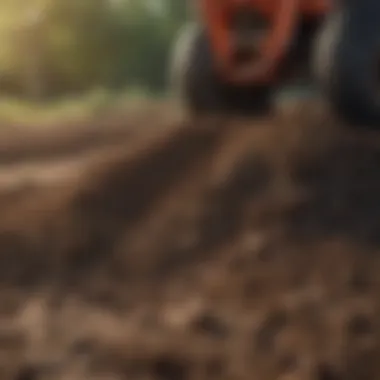Comprehensive Preparation for Laying Sod: A Step-by-Step Guide


Overview of the Topic
Laying sod requires more than just placing grass on the ground. It involves detailed preparation that is crucial for establishing a vibrant and healthy lawn. This process begins with understanding the specific needs of the soil and grass type. A successful sod installation is not merely aesthetic; it contributes to soil health and sustainable landscaping practices.
Definition and Importance
Sod is pre-grown grass that is harvested in strips for easier installation and rapid landscape transformation. This method provides an immediate green cover, but if not done correctly, it can lead to disappointing results. Therefore, preparation effects overall outcomes significantly. Taking the time to assess soil quality, local climate conditions, and the existing site environment ensures that the sod will thrive.
Current Trends
In recent years, the trend towards sustainable practices has influenced how sod is laid. Using native grass species that require less water and fertilizer is gaining traction. Moreover, the incorporation of organic soil amendments helps improve soil structure and nutrient availability, benefitting both the sod and the surrounding ecosystem.
Key Techniques and Practices
The preparation process is integral, ensuring that sod establishes well and lasts long.
Step-by-Step Guide
- Soil Analysis: Assess your soil type and condition. Test for pH, nutrient levels, and texture. This helps determine how much amendment is necessary.
- Site Preparation: Remove debris, rocks, and any old grass. Ensure the area is level by grading it properly to avoid water pooling.
- Soil Amendment: Depending on the soil test results, amend the soil. This could involve adding organic matter such as compost or adjusting pH with lime or sulfur.
- Tilling: Turn the soil to enhance aeration and integrate any amendments effectively. Aim for a depth of about four to six inches.
- Rake and Smooth: Use a rake to create a smooth surface. Remove any clumps to prepare for sod placement.
- Establishing a watering regime: Before laying sod, it is vital that the base soil is moist, but not overly wet.
- Sodding: Lay the sod in a staggered pattern. Ensure edges fit tightly without overlapping to prevent gaps.
Tools and Equipment Needed
To prepare the site adequately and install sod, you will require certain tools:
- Soil test kit
- Rake
- Shovel
- Tiller
- Lawn roller
- Sod cutter
- Watering equipment
Challenges and Solutions
Even with a thorough preparation plan, challenges may arise.
Common Obstacles
- Poor soil quality: Inadequate nutrients can hinder grass establishment.
- Improper installation techniques: Overlapping sod pieces can lead to uneven growth.
- Weather conditions: Excessive heat or rain can disrupt the laying process and establishment.
Innovative Solutions
- Conduct regular soil tests and monitor changes closely.
- Follow best practices for sod placement to ensure snug fits.
- Create a plan for watering based on weather conditions, adjusting as needed.
"Proper preparation prevents poor performance. Taking meticulous steps before sod installation leads to successful outcomes in lawn care."
Considering the above strategies and employing the right techniques can significantly mitigate potential issues and enhance the success of your sod installation. Engaging with local agricultural resources and communities can also provide additional insights into improving practices.
Understanding the Importance of Preparation
Preparation is crucial when it comes to laying sod. The quality of the sod and the health of the turf depend significantly on the groundwork that is laid before installation. Without proper preparation, the sod may not establish well and fail to thrive, resulting in a wasted investment and potential frustration.
Rationale Behind Proper Sod Installation
When installing sod, the rationale behind proper preparation encompasses several factors. First and foremost, the soil provides the necessary nutrients and support for the grass. If the soil is compacted or unhealthy, sod roots cannot penetrate deeply. This impedes the grass's ability to access water and nutrients while establishing itself. Soil preparation ensures that these essential elements are in optimal condition, allowing for successful rooting.
Additionally, preparation involves addressing the physical environment where sod will be laid. This means clearing debris, leveling the area, and ensuring there is adequate drainage. Each of these elements contributes to the overall health of the sod once it is laid. Without such considerations, puddling or other issues may arise, which can lead to disease and poor growth.
Finally, proper installation timing is also part of preparation. The best time to install sod can differ based on local climate and sod type. Understanding these elements helps to time the installation correctly, optimizing the likelihood of success.
Long-Term Benefits of Well-Prepared Turf
Investing time in thorough preparation yields significant long-term benefits for any landscape. A well-prepared sod installation allows for a healthier lawn that is resilient to environmental stresses.
When turf is laid over properly prepped soil, it has a higher chance of establishing strong root systems. This leads to a thicker, more robust lawn that can withstand foot traffic, drought, and pests. Healthy sod also tends to require less maintenance in the long run. This translates to reduced costs in watering, fertilization, and pest management, thus promoting sustainable practices.
Moreover, well-prepared turf enhances the aesthetic value of a landscape. A lush, green lawn becomes a focal point, improving the overall appearance of a property. It can also provide environmental benefits, such as improved air quality and decreased soil erosion.
In summary, preparation is not just a preliminary step; it is a foundational element of sod installation that influences every aspect of turf health and longevity.
Soil Analysis: The First Step
Conducting a thorough soil analysis is crucial for preparing to lay sod. Comprehending the current state of the soil in your area allows for informed decisions on amendments and adjustments needed for optimal growth. Well-prepared soil is the foundation of healthy sod, as it can significantly impact root development and overall turf health. Understanding the nuances of soil characteristics—including texture, structure, and nutrient levels—ensures that the sod laid will establish effectively and thrive long-term.


Testing Soil Quality
Testing soil quality involves examining both its physical and chemical properties. The process typically starts with a soil test kit or sending a sample to a laboratory. Consider the following when assessing soil quality:
- Sample Collection: Collect samples from multiple spots in the area to get a representative mix. This helps identify variations within the soil.
- Physical Characteristics: Analyze aspects such as texture and drainage. Sandy soils drain quicker, while clay types retain moisture. The right balance is crucial for sod establishment.
- Nutrient Levels: Identify key nutrients like nitrogen, phosphorus, and potassium that affect growth. Adequate nutrient levels lead to a healthier final product.
Understanding Soil pH and Nutrients
Soil pH is a critical factor influencing sod installation. It measures the acidity or alkalinity of the soil, impacting nutrient availability. Most sod varieties thrive in slightly acidic to neutral pH, generally between 6.0 and 7.0. Here are key considerations regarding pH and nutrients:
- Nutrient Availability: High acidity can lock away vital nutrients. Similarly, very alkaline soils can affect nutrient uptake. Understanding your soil's pH helps in applying appropriate amendments to reach the desired range.
- Testing Methods: Use pH test kits or professional laboratory services to determine pH levels. This data forms the basis for any necessary adjustments to soil conditions.
- Nutrient Interactions: Different nutrients interact within soil chemistry. For example, if phosphorus is abundant but the pH is low, it might be hard for grass to utilize that phosphorus, leading to poor growth.
Amending Soil for Optimal Conditions
After identifying the soil's characteristics and nutrient levels, the next step is amending the soil to create the best conditions for new sod. Amending tends to include the following:
- Adding Organic Matter: Incorporate compost or well-rotted manure into the soil. Organic matter improves soil structure, enhances moisture retention, and provides nutrients.
- Adjusting pH Levels: If the soil is too acidic, lime can be added to raise the pH. Conversely, elemental sulfur can help lower a high pH. Aim for gradual adjustments.
- Fertilizing Appropriately: Select a balanced fertilizer or any specific nutrient amendments based on soil test results. This nourishes the sod during establishment and supports prolonged growth.
"A well-analyzed soil is the starting point for a successful sod installation. The attention to detail in this initial step cannot be overstated."
In summary, soil analysis is an indispensable first step in laying sod. By understanding soil quality, pH, and recommended amendments, one positions themselves for success. Each phase, from testing to amending, builds a platform for robust turf growth.
Choosing the Right Time for Installation
Choosing the right time for sod installation is critical for ensuring a robust and healthy lawn. The timing affects how well the sod establishes itself in the new environment. Factors such as temperature, seasonal cycles, and moisture conditions play a significant role in the success of the installation. This section delves into the best seasonal practices and necessary weather conditions to consider when planning sod installation.
Best Seasons for Laying Sod
The ideal seasons for laying sod vary based on geographic location. Generally, spring and fall are recognized as the best times. In spring, the soil warms up while temperatures are still moderate, allowing sod to root well before the summer heat. Late summer to early fall is also favorable, as it provides a cooler climate, reducing stress on new grass and allowing roots to grow deep before winter.
- Spring Installation:
- Fall Installation:
- Optimal soil temperature for quick rooting.
- Lesser drought stress than summer installation.
- Provides enough time for rooting before frost.
- Cooler air reduces disease pressure.
It’s imperative to monitor local weather patterns closely and adjust your plan accordingly to ensure that sod can flourish.
Weather Conditions to Consider
Weather plays a substantial part in sod installation. Temperature and moisture need to be at suitable levels to promote growth. Installing sod during hot summer months can lead to rapid drying and stress. Ideally, sod should be laid when temperatures are between 60°F and 75°F. To further aid establishment, consider the following weather conditions:
- Moisture Levels:
- Wind Conditions:
- Light rainfall can benefit sod after installation.
- Avoid installing sod during heavy rains or excessive drought conditions.
- High winds can dry out new sod quickly or even lift it from the ground.
By understanding seasonal patterns and keeping an eye on upcoming weather forecasts, you can make informed decisions that align with establishing a vigorous lawn.
Remember: Timely installation is one of the key factors that define the success of sod establishment. Evaluating your local conditions can be a game changer.
Site Preparation Techniques
Site preparation techniques are crucial for achieving a successful sod installation. This phase ensures that the ground is ready to support lush, healthy turf. Properly preparing the site can minimize future maintenance needs and enhance the overall health of the grass. Ignoring preparation may lead to poor drainage, unhealthy sod, and ultimately a failed landscape project.
Clearing the Area
Before laying sod, it is imperative to clear the area of obstacles. This includes removing any debris, weeds, and existing grass. A clean site prevents competition for nutrients and space, which is vital for the establishment of new sod. Ensure that any rocks, sticks, or excess materials are removed to create a level surface.
Tools such as a shovel, rake, or a thatching machine can aid in this task. Consider using chemical weed killers if necessary. However, be cautious about applying them close to the date of sod installation, as residual chemicals can harm new grass.
Grading the Site for Drainage
Once the area is cleared, grading becomes the next critical step. Grading involves leveling the ground to create a slope that facilitates water drainage. A well-graded site helps prevent water pooling, which can cause issues such as sod diseases and root rot.
Aim for a gentle slope away from structures. This promotes effective drainage while ensuring the sod receives adequate moisture without becoming oversaturated.


When grading, consider using a landscape rake or a level to achieve a smooth surface. Pay attention to low areas that may collect water. Reshape these spots to encourage proper runoff. Undergrading can lead to long-term problems with moisture retention, impacting the viability of the sod.
To summarize:
- Clear the area of all debris and obstacles.
- Remove any existing grass and weeds.
- Grade the site gently to promote drainage.
- Watch for low spots and adjust the grade as needed.
Completing these site preparation techniques sets the foundation for a successful sod installation. Each step contributes significantly to the health and longevity of the lawn.
Tilling and Soil Preparation
Tilling and soil preparation serve as foundational steps in the sod installation process. These practices fundamentally influence the health of the grass, promoting optimal growth conditions. Tilling breaks up compact soil, allowing for improved air and water penetration. This results in a healthier root system, which is essential for establishing strong turf. Moreover, by incorporating organic matter, the soil's nutrient content can be enhanced. This combination of practices ensures that the new sod has the best chance of thriving in its new environment.
How to Properly Till the Soil
Tilling should be approached with careful consideration. Firstly, the best time to till is when the soil is moist but not overly wet. This condition reduces the risk of compaction and creates a suitable texture for the seed bed.
- Select the right equipment: Depending on the size of the area, you may choose a handheld tiller or a larger rototiller. The latter is effective for larger plots but can be difficult to maneuver.
- Depth matters: Aim to till the top 4 to 6 inches of soil. This depth is sufficient to disrupt the old sod and prepare for the new layer.
- Plan for multiple passes: Tilling may require several passes to ensure uniformity. This strategy prevents clumping and compacted sections.
After tilling, it's vital to leave the area to settle for a couple of days before laying sod. This helps the soil regain some stability.
Integrating Organic Matter
Incorporating organic matter into the soil is crucial for creating a fertile environment. Organic matter improves soil structure and enhances its capacity to retain moisture, which is beneficial for new sod. Here are several ways to integrate organic matter into the soil:
- Compost: This is one of the best options. Spread a 1- to 2-inch layer over the tilled soil and mix it in. Compost adds nutrients and beneficial microorganisms.
- Peat moss: This material helps improve soil texture. However, use it sparingly due to its environmental implications.
- Well-rotted manure: Cow or horse manure can be an effective soil amendment if properly aged. This prevents the introduction of harmful pathogens.
Adding organic matter not only enriches the soil but also helps in moisture retention, which is vital for sod establishment.
A successful integration of organic matter together with proper tilling prepares the ground adequately. This well-prepared soil serves as a solid foundation for laying sod, ensuring a vibrant and healthy lawn.
Installation Techniques for Laying Sod
Installing sod is a crucial aspect in achieving a lush and vibrant lawn. The techniques used during installation can greatly influence the success of the sod in establishing roots and thriving in its new environment. This section will detail the essential steps needed to plan and execute the installation of sod effectively.
Planning Sod Layout
Before laying sod, proper planning of the layout is essential. It involves determining the area where the sod will be installed and how the pieces will be arranged. Careful layout planning can enhance the overall appearance of your lawn and ensure more seamless growth of the grass.
- Assess the Area: Measure the area to ensure you order the correct amount of sod. Consider any slopes or unique features in your yard that might affect the installation.
- Design Considerations: Think about the design and how different patches will look together. It is important to choose a layout that minimizes seams and overlaps.
- Consider Sunlight and Drainage: Identify areas that receive sunlight and those that are shady. Also, evaluate how water drains in your yard. These factors will affect the choice of sod type and layout design.
- Use a Plan or Diagram: Sometimes, sketching a diagram can help visualize the layout more efficiently. This can minimize confusion during the actual installation phase.
Proper Placement and Staggering
When laying sod, maintaining proper placement and staggering the seams is vital for the turf's health and longevity. Incorrect placement can lead to gaps or overlapping sod pieces, which can create problems in water distribution and growth.
- Stagger Seams: Similar to laying bricks, staggering the seams of the sod helps to create a stronger and more stable lawn. If seams are aligned, it can cause weak spots.
- Avoid Gaps: When laying each piece of sod, ensure the edges touch. Gaps can lead to weed growth and will create inconsistency in the lawn’s appearance.
- Use Straight Edges: Utilize a straight edge to guide the placement of each piece, ensuring even rows. This method helps with aesthetic appeal and efficient coverage.
- Check Alignment Regularly: Step back and evaluate the alignment as you lay the sod. It is easier to make adjustments while laying rather than after the installation is completed.
Ensuring proper planning and placement during sod installation plays a key role in creating a sustainable and visually appealing lawn.
In summary, effective installation techniques are crucial for setting the foundation of a successful sod operation. With proper layout and correct placement, the sod is well on its way to establishing a healthy and beautiful lawn.
Watering Practices Post-Installation
Understanding the significance of watering practices after laying sod is essential for ensuring the successful establishment of a new lawn. Proper watering not only supports the sod during its initial growth stages but also promotes root acclimation and healthy turf development.
Effective watering methods can help prevent issues like drying out or disease, which can arise from both over- and under-watering. A well-watered sod begins to root into the soil, connecting with nutrients and moisture. Thus, the immediate post-installation period is crucial.
Initial Watering Requirements
When sod is first laid, it is vital to provide adequate initial watering. This process helps to moisten the sod and the underlying soil, ensuring that both layers have sufficient hydration. Right after installation, each section of sod should be watered until the top layer is wet, but avoid flooding the area.
Some key points for initial watering include:
- Timing: Water the sod as soon as it is laid. A quick soak helps protect it from stress.
- Amount: Generally, aim for about 1 to 1.5 inches of water, depending on the climate. This may require adjustments in hotter, drier conditions.
- Technique: Use hose or sprinkler systems; ensure coverage is even but not excessive.
The goal is to eliminate air pockets that might hinder root growth while ensuring that enough moisture reaches the soil beneath.
Establishing a Watering Schedule


After the initial watering, establishing a consistent watering schedule is crucial. This schedule should adapt to the type of grass, climate conditions, and the specific needs of your sod.
Consider these important elements when creating a watering schedule:
- Frequency: For the first two weeks, watering daily is often advisable. This early start helps the sod roots establish in their new environment.
- Duration: Gradually reduce frequency over time while increasing the amount of water given in each session. This encourages deeper rooting.
- Monitoring: Observe the sod regularly. If the grass shows signs of wilting, you may need to adjust the schedule.
Keeping a close eye on sod condition encourages healthy growth and strong establishment.
In summary, proper post-installation watering practices form the backbone of a successful sod development. Paying attention to initial watering and adhering to a flexible yet consistent watering schedule ensures that your fresh sod thrives, setting a foundation for a lush and healthy lawn.
Maintenance Considerations for New Sod
Proper maintenance after laying sod is essential to ensure healthy growth and establishment. The early weeks following installation are critical for the turf's success. This section will delve into crucial maintenance practices that will help new sod thrive, including mowing guidelines and fertilization practices.
Mowing Guidelines for New Growth
Mowing is an essential part of maintaining a new sod lawn. However, it is important to approach this task with care. New grass requires time to establish strong roots. Typically, it is advisable to wait until the grass reaches a height of 3 inches before the first mowing. This height encourages deeper root growth.
When mowing new grass:
- Use a mower with sharp blades to prevent tearing the grass blades.
- Set the mower to the highest setting to avoid cutting too much of the grass at once. This helps protect the young plants.
- Avoid mowing when the grass is wet to minimize damage and not disturb the soil structure.
After the initial cuts, you can gradually lower the mower's height. The goal is to keep a grass height of around 2 to 2.5 inches for most turf varieties. This practice helps maintain moisture and shade the soil, promoting healthy growth.
Fertilization Practices
Fertilization plays a critical role in encouraging robust growth after laying sod. A well-planned fertilization schedule can provide the necessary nutrients that the grass needs to establish. Right after installation, applying a starter fertilizer can significantly enhance root development.
Here are some suggestions for effective fertilization:
- Use a starter fertilizer that is particularly formulated for new sod. Look for a product high in phosphorus, which helps with root growth.
- Apply the fertilizer shortly after installation to give the sod an immediate nutrient supply. Follow the product instructions regarding the amount and application method.
- Reassess fertilization three weeks post-installation. If the grass shows good signs of growth, proceed with a balanced fertilizer high in nitrogen to promote leaf growth.
- Consider soil tests periodically to check nutrient levels. Adjust fertilization based on the results to optimize grass health.
By following these maintenance practices, homeowners can ensure their new sod not only survives but thrives, establishing a lush green lawn for years to come.
Common Mistakes in Sod Installation
Mistakes in sod installation can lead to poor results, making the efforts of preparation and laying sod almost pointless. Avoiding these errors is crucial for establishing a healthy lawn. Understanding common pitfalls can save time and resources while enhancing the lifespan and vitality of the sod. This section highlights two prevalent areas where many enthusiasts falter: overlooking soil health and employing improper watering techniques.
Overlooking Soil Health
Ignoring the quality of soil before laying sod is a severe mistake. Soil health serves as the foundation for grass growth, and neglecting it can severely impact the survival rate of newly installed sod. Factors such as soil type, nutrient content, and pH play significant roles in grass establishment.
When sod is placed on poor-quality soil, it struggles to absorb the necessary nutrients and water. This leads to weak growth, discoloration, and susceptibility to pests and diseases. Therefore, conducting a thorough soil analysis before installation is essential. Look for signs of compaction and ensure proper drainage to avoid saturation issues. Adding organic matter or fertilizers, based on the soil’s nutrient profile, can greatly improve the soil condition, making it fertile for the sod to thrive.
Consequently, the benefits of maintaining soil health include:
- Improved water retention and availability.
- Enhanced nutrient accessibility.
- Stronger root development.
- A healthier lawn with greater resistance to disease and wear.
Improper Watering Techniques
Watering sod correctly is crucial in the establishment phase. Many people make the error of either overwatering or underwatering their new sod, leading to detrimental effects. Overwatering can suffocate the roots, cause mold, and lead to issues with waterlogged soil. On the other hand, underwatering limits hydration, causing the grass to dry out, wilt, and eventually die.
To avoid these mistakes, It is key to follow these guidelines for effective watering:
- Initial Watering: Water immediately after laying sod to ensure it makes contact with the soil and begins to establish roots. The top layer of soil should remain moist but not soggy during the first couple of weeks.
- Ongoing Maintenance: Establishing a schedule is important. Sod typically requires about one inch of water per week, which can include rainfall. Adjust this as needed based on environmental conditions.
- Signs of Water Stress: Keep an eye on the grass for signs of under or overwatering - discoloration, wilting, or mushy areas should prompt a review of your watering practices.
Ending: Strategies for Success
Concluding a thorough guide on laying sod, it becomes crucial to underscore the significance of the strategies discussed throughout. Proper preparation is paramount to ensure not just the aesthetic appeal of a lawn but its long-term viability and health. Each element, from soil analysis to effective watering techniques, contributes to achieving a lush and resilient turf. The key is not merely in execution but the systems implemented prior to the installation of sod.
Recap of Key Steps
To summarize, the successful establishment of sod hinges on a comprehensive process:
- Soil Analysis: Begin by evaluating soil composition, pH, and nutrient levels to understand the foundation where your sod will thrive.
- Site Preparation: Clear and grade the area to ensure proper drainage and optimal growing conditions.
- Timing: Choose the best season and weather conditions for installation, as this greatly affects sod growth and establishment.
- Installation: Apply effective techniques when laying sod, such as staggering joints and aligning edges for a seamless lawn appearance.
- Watering: Implement a sustainable watering routine immediately after placement to promote rooting and establishment without over-saturation.
- Maintenance: Follow up with the necessary maintenance practices to support growth, including mowing and fertilization.
By following these steps, the risk of common installation errors diminishes and the success of a verdant lawn is elevated.
Encouragement for a Thoughtful Approach
A thoughtful approach is critical when undertaking any landscape project, particularly sod installation. Each yard has unique conditions that affect growth potential. Adjusting methods based on individual soil characteristics, climate conditions, and regional practices leads to better outcomes.
Reflecting on sustainable practices is also essential. Every action taken with the intention of maintaining healthy turf impacts the surrounding environment and ecosystem. Therefore, consider this when selecting fertilizers and pest control measures, opting for organic solutions where possible.
In summary, while laying sod may appear to be a straightforward task, the depth of preparation sets the stage for success. Engaging in a meticulous planning process and staying informed will ultimately yield a landscape that is not only pleasing to the eye but also ecologically sound.



